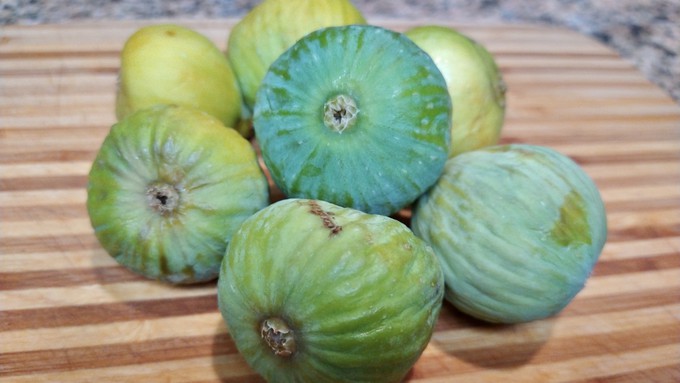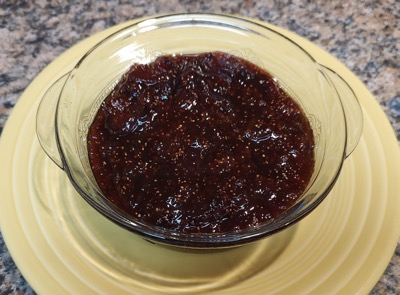
Recipe: Easy fig compote with orange and vanilla

These fresh Kadota figs will become compote -- much easier than jam. Debbie Arrington
I love fig jam, but I rarely have enough ripe figs at the same time to make a large batch. Also, ripe figs are pretty sweet on their own. Do they really need all that extra sugar?
The solution: Make fig compote. The recipe can be scaled up or down according to the amount of ripe figs on hand. And it uses just a fraction of the sugar as traditional jam.
What’s the difference between jam and compote? Jam relies on lots of sugar to preserve the fruit. With about equal parts mashed fruit to sugar, it has a more even texture and is easier to spread on toast. Compote uses larger chunks of fruit and less sugar. It tends to be more sauce than spread but -- with soft fruit like figs -- can still top toast or English muffins. Since it contains less sugar, compote has a shorter shelf life. It’s made to enjoy right away (or be kept in the refrigerator).
Another plus for compote: No added pectin is necessary. The mixture naturally thickens as it cooks.

This easy compote keeps the fig color and flavor bright with the addition of an orange – its juice and zest. Vanilla adds another interesting note of flavor.
While slightly under-ripe figs are best for jam, this compote can use figs so ripe they’re almost falling apart. Another plus: There’s no need to peel.
Serve fig compote as an accompaniment to grilled pork or poultry, alongside brie on a cheese platter or as a topping on vanilla ice cream. Or spread it on some crackers or toast.
Easy fig compote
Makes about 2 cups
Ingredients:
1 pound ripe figs
1 whole orange
¾ cup sugar
1 teaspoon vanilla
Instructions:
Cut stems off figs. Cut figs into quarters, then half each quarter.
Transfer to a heavy saucepan.
Zest the orange, then juice the orange, straining out any seeds. Add orange zest and juice to the figs. Stir in sugar.
Over medium heat, heat the fig mixture to a boil, stirring often. Let boil for 1 minute, then reduce the heat to low. Simmer the fig mixture, stirring often, until it reaches its desired thickness – about 20 to 30 minutes. The compote should be thick and mound in a spoon.
Once it reaches desired thickness, remove compote from heat and stir in vanilla. Let cool.
Store compote covered in the refrigerator; use within a week. Remove from the refrigerator 30 minutes before serving.
Fig compote also can be frozen for up to 6 months.
Comments
0 comments have been posted.Sacramento Digs Gardening to your inbox.
Sites We Like
Garden Checklist for week of Oct. 27
It's still great weather for gardening. Grab a sweater – and an umbrella, just in case – then get to work:
* October is the best month to plant trees, shrubs and perennials.
* Harvest pumpkins and winter squash.
* Pick apples and persimmons. Remember to pick up fallen fruit, too; it attracts pests.
* Clean up the summer vegetable garden and compost disease-free foliage.
* Dig up corms and tubers of gladioli, dahlias and tuberous begonias after the foliage dies. Clean and store in a cool, dry place.
* Treat azaleas, gardenias and camellias with chelated iron if leaves are yellowing between the veins.
* Now is the time to plant seeds for many flowers directly into the garden, including cornflower, nasturtium, nigella, poppy, portulaca, sweet pea and stock.
* Plant seeds for radishes, bok choy, mustard, spinach and peas.
* Plant garlic and onions.
* Set out cool-weather bedding plants, including calendula, pansy, snapdragon, primrose and viola.
* Reseed and feed the lawn. Work on bare spots.